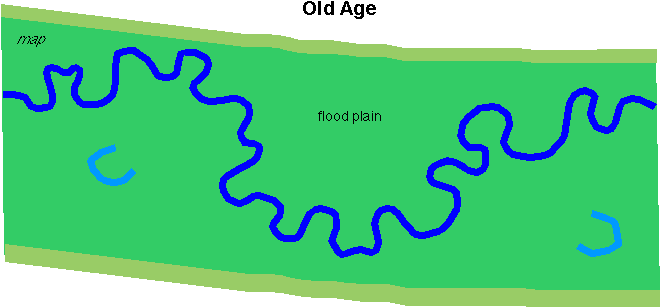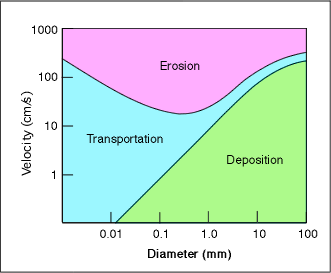
Stream Processes
Stream Flow and Sediment Transport
Stream velocity is the speed of the water in the stream. Units are distance per time (e.g., meters per second or feet per second). Stream velocity is greatest in midstream near the surface and is slowest along the stream bed and banks due to friction.
Hydraulic radius (HR or just R) is the ratio of the cross-sectional area divided by the wetted perimeter. For a hypothetical stream with a rectangular cross sectional shape (a stream with a flat bottom and vertical sides) the cross-sectional area is simply the width multiplied by the depth (W * D). For the same hypothetical stream the wetted perimeter would be the depth plus the width plus the depth (W + 2D). The greater the cross-sectional area in comparison to the wetted perimeter, the more freely flowing will the stream be because less of the water in the stream is in proximity to the frictional bed. So as hydraulic radius increases so will velocity (all other factors being equal).
Stream discharge is the quantity (volume) of water passing by a given point in a certain amount of time. It is calculated as Q = V * A, where V is the stream velocity and A is the stream's cross-sectional area. Units of discharge are volume per time (e.g., m3/sec or million gallons per day, mgpd).
At low velocity, especially if the stream bed is smooth, streams may exhibit laminar flow in which all of the water molecules flow in parallel paths. At higher velocities turbulence is introduced into the flow (turbulent flow). The water molecules don't follow parallel paths.
Streams carry dissolved ions as dissolved load, fine clay and silt particles as suspended load, and coarse sands and gravels as bed load. Fine particles will only remain suspended if flow is turbulent. In laminar flow, suspended particles will slowly settle to the bed.
Hjulstrom's Diagram plots two curves representing 1) the minimum stream velocity required to erode sediments of varying sizes from the stream bed, and 2) the minimum velocity required to continue to transport sediments of varying sizes. Notice that for coarser sediments (sand and gravel) it takes just a little higher velocity to initially erode particles than it takes to continue to transport them. For small particles (clay and silt) considerably higer velocities are required for erosion than for transportation because these finer particles have cohesion resulting from electrostatic attractions. Think of how sticky wet mud is.

Stream competence refers to the heaviest particles a stream can carry. Stream competence depends on stream velocity (as shown on the Hjulstrom diagram above). The faster the current, the heavier the particle that can be transported.
Stream capacity is the maximum amount of solid load (bed and suspended) a stream can carry. It depends on both the discharge and the velocity (since velocity affects the competence and therefore the range of particle sizes that may be transported).
As stream velocity and discharge increase so do competence and capacity. But it is not a linear relationship (e.g., doubling velocity and discharge do not simply double competence and capacity). Competence varies as approximately the sixth power of velocity. For example, doubling the velocity results in a 64 times increase in the competence.
Capacity varies as the discharge squared or cubed. So tripling the discharge results in a 9 to 27 times increase in the capacity.
Therefore, most of the work of streams is accomplished during floods when stream velocity and discharge (and therefore competence and capacity) are many times their level during low flow regimes. This work is in the form of bed scouring (erosion), sediment transport (bed and suspended loads), and sediment deposition.
Stream Dynamics
Perennial and Ephemeral Streams
Gaining (effluent) streams receive water from the groundwater. In other words, a gaining stream discharges water from the water table. On the other hand losing (influent) streams lie above the water table (e.g., in an arid climate) and water seeps through the stream bed to recharge the water table below. Gaining streams are perennial streams: they flow year around. Losing streams are typically ephemeral streams: they do not flow year round. Th. only flow when there is sufficient runoff from recent rains or spring snowmelt. Some streams are gaining part of the year and losing part of the year or just in particular years, as the water table drops during an extended dry season.
Streams have two sources of water: storm charge, from overland flow after rain events, and baseflow, supplied by groundwater.
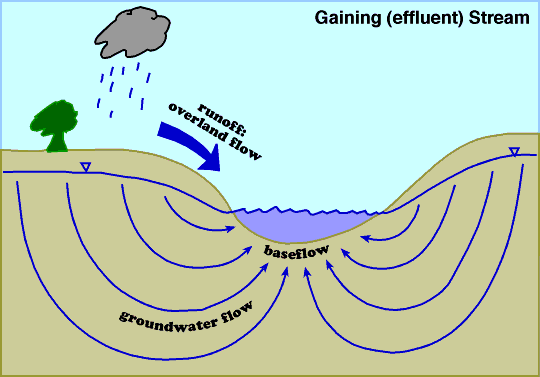
Flood Erosion and Deposition: As flood waters rise, the slope of the stream as it flows to its base level (e.g., the ocean or a lake) increases. Also, as stream depth increases, the hydraulic radius increases thereby making the stream more free flowing. Both of these factors lead to an increase in stream velocity. The increased velocity and the increased cross-sectional area mean that discharge increases. As discharge and velocity increase so do the stream's competence and capacity. In the rising stages of a flood much sediment is dumped into streams by overland flow and gully wash. This can result in some aggradation or building up of sediments on the stream bed. However, after the flood peaks less sediment is carried and a great deal of bed scouring (erosion) occurs. As the flood subsides and competence and capacity decline sediments are deposited and the stream bed aggrades again. Even though the stream bed may return to somewhat like its pre-flood state, huge quantities of sediments have been transported downstream. Much fine sediment has probably been deposited on the flood plain.
Stream Patterns
Meandering Streams: At a bend in a stream the water's momentum carries the mass of the water against the outer bank. Water piles up on the outer bank making it a little deeper and the inner bank a little shallower. The greater depth on the outer side of the bend also leads to higher velocity at the outer bank. The greater velocity combined with the greater inertial force on the outer bank erodes a deepr channel. The deeper channel reinforces the velocity increase. The inner bank remains shallower, increasing friction, thereby reducing the velocity.
Where the depth and velocity of the water on the outer bank increase so do the competence and capacity. Erosion occurs on the outer bank or cut bank. Where velocity of the water on the inner bank decreases so do the competence and capacity. Deposition occurs, leading to the formation of a point bar. Over time, the position of the stream changes as the bend migrates in the direction of the cut bank. As oxbow bends accentuate and migrate, two bends can erode together forming a cutoff and leaving an oxbow lake.
Graded Streams: Considering the longitudinal (downstream) profile of
a stream:
Where a stream flows down a steep slope velocity will increase which will result
in increased erosion. Where that stream then flows onto a gentler slope velocity
decreases and deposition will result. This process will reduce the slope of
steep stretches and increase the slope of flatter stretches resulting in a more
even slope through the course of the stream.
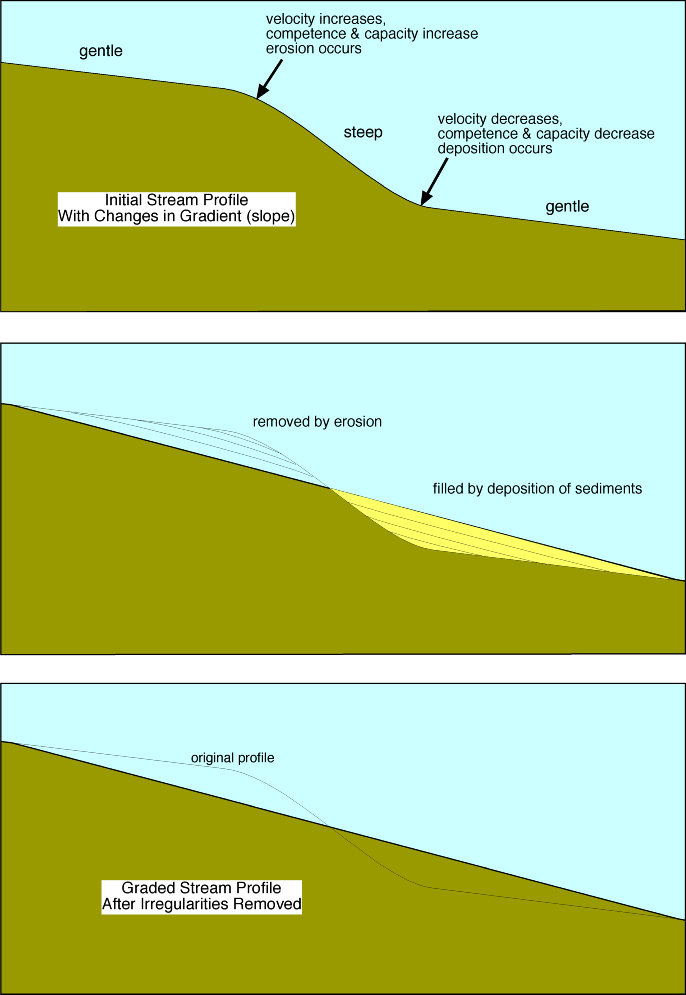
The ideal graded profile of a stream is concave upward: steeper near the head or beginning and flatter near the bottom or mouth of the stream. The reason for this is that in the upper reaches of a stream its discharge is smaller. As streams merge with other streams their discharge increases, their cross-sectional area increases, and their hydraulic radius increases. As one goes downstream and the stream grows in size the waters flow more freely. In the upper reaches, a small stream must be steeper to transport its sediments. The extra gravitational energy on the steeper slope is needed to overcome the frictional forces in the shallow stream. If the slope is too gentle and velocity is too slow to transport the sediments being supplied by weathering and erosion, the sediments will pile up. This increases the gradient which causes the water to flow faster which increases erosion and transport, which then reduces the gradient. In the lower reaches of a stream, where the discharge is greater, since friction is less the stream need not be so steep to transport the load. If it were steeper than needed to transport the sediments erosion would result. But this would decrease the gradient leading to a decrease in erosion.

It seems counter-intuitive but stream velocity generally doesn't decrease on average, on the large scale from the steep headlands to the flat plains, from the dashing moutain brook to the broad peaceful river. The broad lowland rivers have much greater discharge and hydraulic radius. They flow much more freely (e.g., the water doesn't have to dash around boulders in the stream). The net result is that velocity actually increases somwhat.
Braided Stream patterns are found where there is a very large bed load where there is either a high sediment supply or the stream lies on a loose, unconsolidated bed of sand and gravel. In braided streams the stream does not occupy a single channel but the flow is diverted into many separate ribbons of water with sand bars between.
Stream Valley Evolution
Youthful Stream Valleys have steep-sloping, V-shaped valleys and little or no flat land next to the stream channel in the valley bottom.
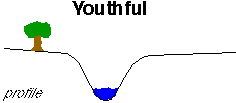
Mature Stream Valleys have gentle slopes and a flood plain; the meander belt width equals the flood plain width.
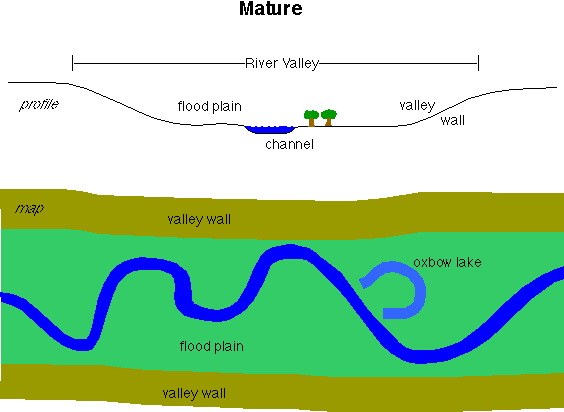
Old Age Stream Valleys have very subdued topography and very broad flood plains; the flood plain width is greater than the meander belt width.
